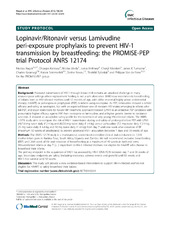Lopinavir/Ritonavir versus Lamivudine peri-exposure prophylaxis to prevent HIV-1 transmission by breastfeeding: the PROMISE-PEP trial Protocol ANRS 12174
Nagot, Nicolas; Kankasa, Chipepo; Meda, Nicolas; Hofmeyr, Justus; Nikodem, Cheryl; Tylleskär, Thorkild; Tumwine, James K.; Karamagi, Charles; Sommerfeldt, Halvor; Neveu, Dorine; Van de Perre, Philippe; for the PROMISE-PEP group
Peer reviewed, Journal article
Published version
Permanent lenke
https://hdl.handle.net/1956/6615Utgivelsesdato
2012-10-06Metadata
Vis full innførselSamlinger
Originalversjon
https://doi.org/10.1186/1471-2334-12-246Sammendrag
Background: Postnatal transmission of HIV-1 through breast milk remains an unsolved challenge in many resource-poor settings where replacement feeding is not a safe alternative. WHO now recommends breastfeeding of infants born to HIV-infected mothers until 12 months of age, with either maternal highly active antiretroviral therapy (HAART) or peri-exposure prophylaxis (PEP) in infants using nevirapine. As PEP, lamivudine showed a similar efficacy and safety as nevirapine, but with an expected lower rate of resistant HIV strains emerging in infants who fail PEP, and lower restrictions for future HIV treatment. Lopinavir/ritonavir (LPV/r) is an attractive PEP candidate with presumably higher efficacy against HIV than nevirapine or lamivudine, and a higher genetic barrier to resistance selection. It showed an acceptable safety profile for the treatment of very young HIV-infected infants. The ANRS 12174 study aims to compare the risk of HIV-1 transmission during and safety of prolonged infant PEP with LPV/r (40/10 mg twice daily if 2-4 kg and 80/20 mg twice daily if >4 kg) versus Lamivudine (7,5 mg twice daily if 2-4 kg, 25 mg twice daily if 4-8 kg and 50 mg twice daily if >8 kg) from day 7 until one week after cessation of BF (maximum 50 weeks of prophylaxis) to prevent postnatal HIV-1 acquisition between 7 days and 50 weeks of age. Methods: The ANRS 12174 study is a multinational, randomised controlled clinical trial conducted on 1,500 mother-infant pairs in Burkina Faso, South Africa, Uganda and Zambia. We will recommend exclusive breastfeeding (EBF) until 26th week of life and cessation of breastfeeding at a maximum of 49 weeks in both trial arms. HIV-uninfected infants at day 7 (± 2 days) born to HIV-1 infected mothers not eligible for HAART who choose to breastfeed their infants. The primary endpoint is the acquisition of HIV-1 (as assessed by HIV-1 DNA PCR) between day 7 and 50 weeks of age. Secondary endpoints are safety (including resistance, adverse events and growth) until 50 weeks and HIV-1-free survival until 50 weeks. Discussion: This study will provide a new evidence-based intervention to support HIV-1-infected women not eligible for HAART to safely breastfeed their babies.

